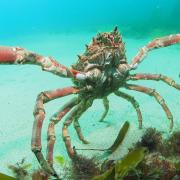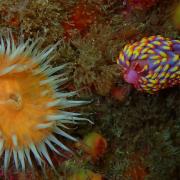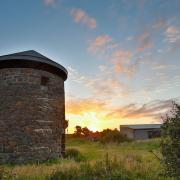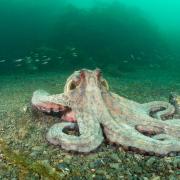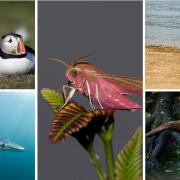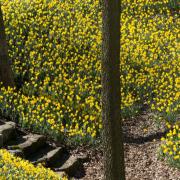The two largest wading birds in Cornwall are the grey heron and the spoonbill. David Chapman tells us how to identify them and where they can be spotted in Cornwall
Waders to Watch
The two largest wading birds in Cornwall are the grey heron and the spoonbill. David Chapman tells us how to identify them and where they can be spotted in Cornwall
I suppose many readers might be surprised at my inclusion of the spoonbill in a Cornish magazine, maybe feeling that this is a rather more exotic bird! However, the fact is that spoonbills are now regularly seen in Cornwall, particularly during the winter. It is true that most spoonbills breeding in Europe do so in the south east of the continent, but there are some colonies in Holland on the island of Texel, and I presume that some of those birds head westwards for the winter to enjoy our milder winter weather. There have also been recent records of spoonbills breeding in Britain. As a result, spoonbills are being seen in increasing numbers in Cornwall and any time between now and mid-May will give us our best opportunity of seeing one.
The single most reliable location for spoonbills is on the Lynher estuary and probably the easiest way to get good views of them is from one of the Avocet cruises organised through the winter months. Last year, though, there were also six spoonbills at Walmsley Sanctuary, near Wadebridge.
Walmsley Sanctuary is a bird reserve owned and managed by Cornwall Birdwatching and Preservation Society (CBWPS). In charge of the day-to-day management of this reserve is Adrian Langdon, who I chatted to about the spoonbills. He told me that the spoonbills would feed on the marshes alongside the River Camel and then fly back to Walmsley Sanctuary to bathe, preen and roost. There were six birds to begin with but it seems that one might have been badly hurt and perished in the cold spell, last January. The number reduced to just three birds, as two of the others moved on naturally.
The spoonbill is fairly unmistakable. It has a wing span of about 120cm and in flight holds its neck and legs out straight, making it look big and gangly. Being quite gregarious it rarely flies on its own, instead it flies head to tail in a line, the birds possibly slip-streaming each other to reduce effort. Its plumage is almost all white, with a couple of exceptions; birds in breeding plumage have a yellowish neck band and head plumes, while juveniles have slightly darker wing tips.
If seen close-up, the huge spoon-shaped bill becomes more obvious. It moves its head from side to side using its bill to catch prey such as shrimps but it will also take small fish, tadpoles, molluscs and dragonfly larvae. Its bill is mostly black with a yellow tip and its legs are entirely black.
Grey heron
The grey heron is a much more familiar bird to us all. Unlike the spoonbill, grey herons are with us all year round and breed in Cornwall. We have a handful of heronries in the county, most of which occur in treetops. One great place to sit and watch them is in Mill Pool car park in West Looe. Across the river here we get great views of the herons at their nests and fishing along the water’s edge. At Marazion Marsh RSPB Reserve the herons nest on the ground. Views of them have improved somewhat over recent years since the reeds have been cut more to provide channels for herons to fish in. From the roadside along the seafront you can see herons at their nests in early spring.
My best ever views of grey herons in Cornwall have been at the National Seal Sanctuary in Gweek. At feeding time members of staff throw lots of fish in for the seals and some grey herons have learned to nip in and snatch the odd fish from the jaws of the grey seals. This doesn’t happen every day but around the nursery pools I have watched grey herons from a distance of about four metres, a wonderful sight!
The grey heron is a patient hunter, often standing still for long periods until a larger fish comes close enough to be speared by the heron’s dagger-like bill. Other prey items taken include frogs, small mammals and even some young birds.
It is true that the grey heron has grey wings but its white belly, breast and head are quite intricately marked with black details. Most appealing is the bird’s black head stripe, which ends in a long nape plume. In flight the heron tucks its head in, while its long yellowish legs trail behind. When relaxed and flying at height its dark wings are bowed giving a characteristic profile.
Where to find reserves
• Walmsley Sanctuary is at SW 990745, or nearest postcode PL27 6EX. It is open only to members of the CBWPS and the hide is locked to prevent non-members gaining access, though there is a public footpath from Trewornan Bridge to Lower Amble which affords limited views over the area.
• Parking is available in lay-bys beside the B3314 from Wadebridge to Rock, just before the bridge. Access to the reserve is found along the same public footpath on the north side of the bridge. There are no facilities on site except the two hides. Conditions underfoot on the approach to the hides can get muddy.
• Membership of the CBWPS currently costs �14 for adults. Members receive a professional quarterly newsletter called Palores and a comprehensive annual report of ‘Birds in Cornwall’. Further details about the society can be found at www.cbwps.co.uk
• For details about the Avocet Cruises on the Tamar and Lynher estuaries call Tamar Cruising on 01752 822105, www.tamarcruising.com
• The National Seal Sanctuary at Gweek, near Helston, TR12 6UG. It opens from 9am-5pm. www.sealsanctuary.co.uk
• Access to the RSPB’s Marazion Marsh, TR17 OEF, is free. For further details about the RSPB visit www.rspb.org.uk









